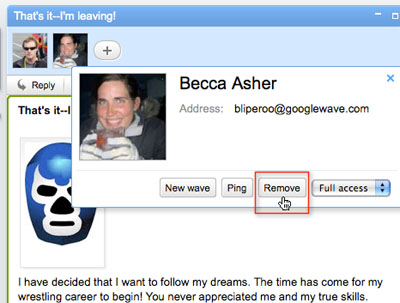Google Wave may be going away, but it is highly unlikely that the web has felt its presence for the last time. As Google said in its announcement, the company will "extend the technology for use in other Google projects."
Were you able to find a reason to use Google Wave? Tell us about it.
It will be interesting to see if the technology still goes by the name "Wave", but I have little doubt that some of the innovations we’ve seen in Wave will be popping up in various Google offerings in the form of new products and new features to existing products.
Google’s aim with Wave was to replace email. That didn’t happen, and frankly, I have a hard time believing that too many people bought into that one, but that didn’t change the fact that Wave did some interesting things. One only had to watch a demo or two from someone who knew what they were doing to see its potential.
The question is where will Wave fit into the Google universe if not as its own product? Gmail? If replacing email was the plan, it would make sense that some Wave-like features appear in Gmail, especially given Google’s penchant for adding features (and labs experiments) to it.
How about "Google Me"? It’s still unclear what Google is up to with this rumored social media project that everyone has been considering the company’s move to rival Facebook, despite no announcments from Google or any real evidence. Wave certainly has social (not to mention realtime) elements that could factor into a broader social networking plan.
Here are a few significant moves by Google that may also contribute:
– Google is getting into gaming. Besides a reported investment in Zynga and talks with Playdom and Playfish, the company has reportedly agreed to acquire game company Slide.
– All YouTube users will be required to have a Google account
– Google is letting users sign into multiple accounts at the same time from the same browser. This could be big for businesses wanting control over multiple accounts more conveniently.
– One of the biggest trends in social media right now is that of checking in. Well, Google is focusing on that too with its Google Places API.
Of the company’s social media plans (apparently being run now by Vic Gundotra), Eric Schmidt says that Google isn’t looking to create another Facebook. "Facebook versus Google…We’re not trying to do what Facebook does. The world does not need another Facebook," he is quoted as saying.
Well, some privacy advocates may disagree with that (though Google’s reputation for privacy doesn’t exactly have the best track record). Either way, regardless of how Google pitches whatever strategy it has (not another Facebook), the fact remains that Facebook is eating up much of consumers’ time online, and that is no doubt time that Google would prefer be spent with their properties. So from that standpoint, Google vs. Facebook is very real. It’s about mind share, and ultimately about advertising. If Facebook ever uses the Open Graph to build its own AdSense-like network, then it will really be real.
But back to Wave’s role in Google’s future. How about Chrome? Wave functionality from the browser? Chrome OS? Wider adoption could be more easily achieved from the browser or the operating system. Any of this could be tied to whatever "Google Me" turns out to be, as long as it is connected by a Google Account.
People will call Wave a failure and stick it in the box of past Google social media failures, but Wave (or at least some of the concepts behind it) will be felt in the future.
"We liked the (user interface) and we liked a lot of the new features in it (but) didn’t get enough traction, so we are taking those technologies and applying them to new technologies that are not announced," CNET quotes Google CEO Eric Schmidt as saying. "We’ll get the benefit of Google Wave but it won’t be as a separate product."
Is it just me or does Google seem to be pulling the plug on Wave a little early? Could they already have a specific new strategy in mind for it that they’re already moving forward on?
What do you think about Google Wave? Sad to see it go or good riddance? Share your thoughts.

 272
272  29
29 




 The project will include:
The project will include:
 David Crane, the founder of Debatewise, is the developer behind the push, and he was asked to write about it on the
David Crane, the founder of Debatewise, is the developer behind the push, and he was asked to write about it on the 



 Interestingly, this initial version is still a little rough around the edges in terms of functionality. Also, there are just 18 extensions listed at the moment, and Google’s suggested design tweaks are on the way. We’ll let you decide whether the company’s gotten ahead of itself or made a smart move by involving developers and users as soon as possible.
Interestingly, this initial version is still a little rough around the edges in terms of functionality. Also, there are just 18 extensions listed at the moment, and Google’s suggested design tweaks are on the way. We’ll let you decide whether the company’s gotten ahead of itself or made a smart move by involving developers and users as soon as possible.